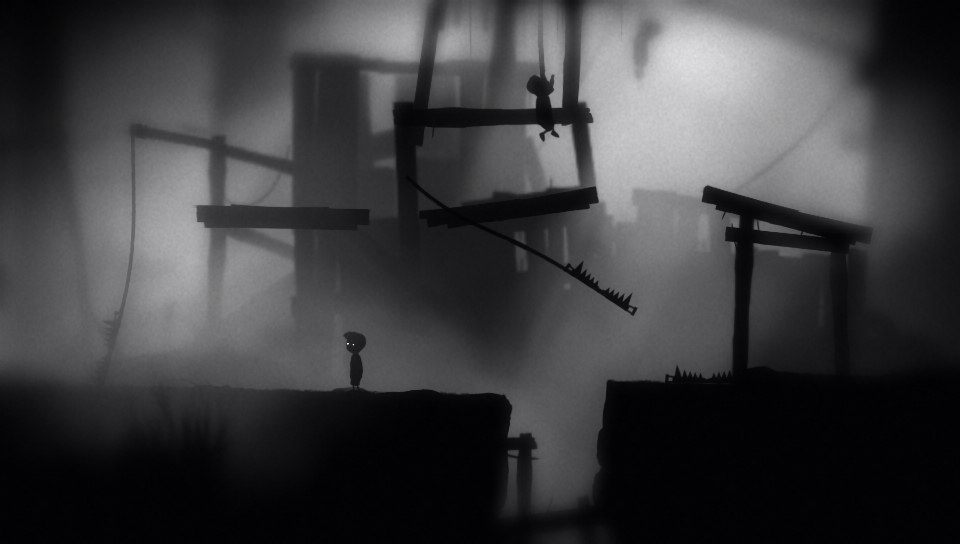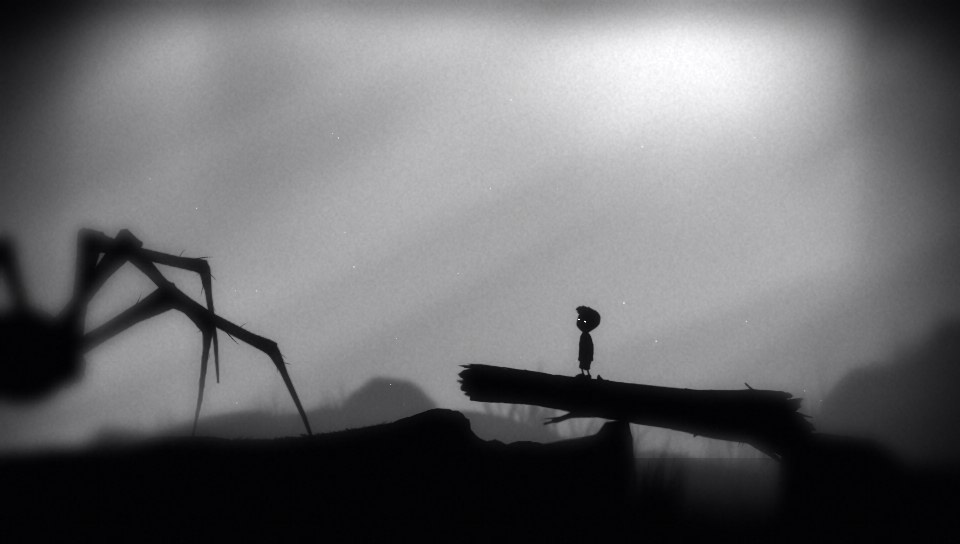Almost three years after Limbo landed on the Xbox 360, it finally arrives on the Vita. Limbo is nearly unchanged from its previous incarnations, and in it, you roam through ink-black locales, overcoming traps while braving the suffocating atmosphere. Intuitive puzzles prove just as satisfying on the go; however, the aesthetics are not quite as arresting on the small screen. It's a tiny problem that results in a mere blemish on this translation. Whether you've been enthralled by this poor boy's trek through a strange world before or have yet to experience this somber journey, Limbo is an artistic adventure that takes hold of your imagination and refuses to let go.

The opening scene thrusts you into this world without any explanation for your predicament. You play as a young child who finds himself lying on his back in a foreign land that is far from welcoming. He is nondescript, appearing as a black silhouette that blends in with his dark surroundings. His lone distinctive characteristic is his shining, white eyes. These flashes of light are always visible, making it the one part of his body you can recognize even when the rest of the screen is completely black. There is no story pushing you through this quest, no signs to give you hints nor characters to clue you in on an overarching plot. Rather, this is a game about survival, where merely making it from one area to the next, surviving one obstacle after another, is what pushes you on.
You have a small repertoire of moves to help you stay alive in this 2D puzzle/platformer hybrid. A modest jump allows you to clear small gaps; certain objects can be pushed or pulled; and you can climb up or swing from ropes. Submerging yourself too deep in water, falling from a high ledge, or making contact with any of the numerous traps kills you instantly. Your lack of heroic moves does not mean that the puzzles you must overcome are equally limited, though. There's plenty of variety in Limbo's puzzles, and even those that appear similar initially are invariably quite different. The early puzzles are single-step affairs that require you to move a bear trap out of the way or cross a river. But later puzzles are much more complex, forcing you to use objects, flip switches, and perform perfect jumps in order to come out on top.
Trial and error is a major component of Limbo's environmental hazards. A boulder may roll unexpectedly toward you, crushing you before you have a chance to react. Or you may stumble upon a bear trap hidden in foliage. Death is quick and brutal. Checkpoints quickly return you to the scene of your demise, so there's no need to walk over the same ground more than once. Once you understand the viciousness present in Limbo, and realize that your precious life can be taken away at a moment's notice, you notice these traps before they can kill you. It's an amazing feeling when you recognize an obstacle way off in the distance, pulling you ever further into this adventure.

Limbo is an expertly paced adventure where progress is made much faster than in a typical game that emphasizes puzzles. Most obstacles can be completed in just two or three attempts, so even though you may have to analyze your surroundings to progress, you rarely dwell on any one section for long. This is one of Limbo's greatest strengths. The stifling aesthetics swirl in your mind, trapping you fully in this world. Dread follows your every step. But once digested, the feeling of hopelessness in each inhospitable section dissipates. That's why it's so important that you keep marching forward. Limbo wants you to progress, to see each unnerving location, and understand the plight this poor child faces.
The subdued aesthetics are the main draw of Limbo. Subtle audio hooks and restrained visuals guide you further along your destined path, never offering a moment of respite. You walk through dense forests, decrepit towns, and abandoned factories, all of which feel confined and desolate. Everything is tarnished beyond repair. The audio beautifully complements the darkness. Ambient noises send shivers down your spine. The snap of a branch or chirping of crickets sounds so real, so normal, that it makes this shadowy land even more surreal. And when the music plays, it crashes down in full force, awakening you with a start. However, as great as the artistic design is, it doesn't work as well on the Vita. The small screen doesn't do justice to the utter bleakness, making you feel less immersed in this grim world. For many games, this wouldn't be a problem. But for Limbo, which is so reliant on making sure you're always completely invested, it does slightly lessen the experience.
Even though there aren't developed characters or a story to care about, Limbo elicits a strong emotional connection. The striking visuals and low-key audio are instrumental in pulling you in, but it's the harsh manner in which death is depicted that evokes the most powerful reaction. This is a violent game. The boy can die in a wide variety of ways, and every death is incredibly painful to behold. Bear traps cut him into pieces, spikes impale him, and electrical currents shoot through his body. The elaborate death sequences do not feature excessive amounts of blood, but they are affecting nonetheless because of their shocking depictions. Death is handled in such a cold manner that it continually shocks, even after you've seen it dozens of times. This creates an emotional immediacy that is difficult to forget.

Limbo poses the questions of death versus life and reality versus dream, but it doesn't answer them. It's the questions that are important here, and you're left to contemplate the meaning of this world for yourself. Although this is a game without clear-cut answers, the lack of concrete explanations doesn't detract one bit from the overall experience. This is a delicately crafted adventure whose elements tie seamlessly together. The fact that you can finish the entire game in just a few hours is disappointing only because it's so difficult to pull yourself away once you've been sucked in. Limbo is a wonderful adventure from beginning to end.